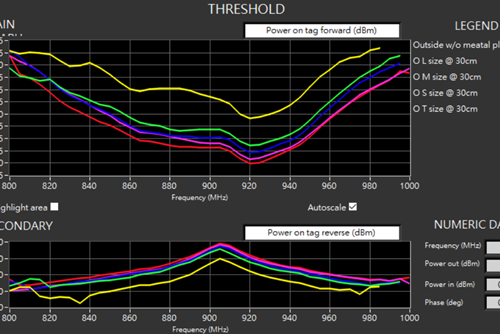Following research activities of RFID is a nice way to keep up with the latest technology developments. Awareness of hot research topics also helps in anticipating the direction of commercial development and new product launches. Here is my take on the published RFID research in 2017. I have included short comments on the research topics, and a number of links to papers published in 2017 that have caught my attention – for one reason or another.
First, a disclaimer: the selection of the introduced research papers and overview is my own. Summaries of the articles are short and written from my personal perspective, the points I raise are not necessarily same as authors’ intentions. When the topic seems interesting, I recommend clicking the link and reading the whole article.

Sensor Tags
RFID sensors continue to be one of the main research areas. The topic is wide – there are a lot of parameters that can be sensed, and the ways to sense ambient conditions are vast. New materials provide new possibilities for sensing, and existing methods have been fine-tuned to solve specific problems.
- Graphene seems to offer a way to amplify ambient conditions’ effect on RFID tag tuning. This effect can be used in sensor tags. Research paper “Graphene oxide dielectric permittivity at GHz and its applications for wireless humidity sensing” introduces a printed graphene tag antenna coated with graphene oxide. The antenna changes properties when graphene oxide bonds with water molecules. The changing properties can be detected as a changed backscatter signal strength and phase.
- Another approach to detect ambient conditions utilizes bimetal strips. Research paper “A Passive Temperature-Sensing Antenna Based on a Bimetal Strip Coil” presents a tag antenna combined with bi-metal strip. Antenna changes its’ tuning when ambient temperature changes.
- Another research project “UHF passive RFID‐based sensor‐less system to detect humidity for irrigation monitoring” starts from a practical application. The paper describes a tag and a method for monitoring soil humidity. The tag is designed and tuned to provide high read range when buried to dry soil. In properly irrigated soil the read range drops. Farmers can thus monitor field condition just by checking whether tags buried to soil can be read or not.
- In my mind, I associate energy harvesting with sensor tags. This paper “Performance Evaluation of a Long-Range RFID Tag Powered by a Vibration Energy Harvester” describes a vibration energy harvesting component used to boost read range of a semi-passive tag. Even though in the described application the harvested energy is used to boost the tag’s read range, I could see the component applied to RFID sensors logging data.
Healthcare and Wellness
Healthcare and wellness related sensor tag applications is a wide research area on its own. Research is aiming to fulfill the potential of RAIN RFID technology in healthcare. Amount of research related to RFID in healthcare is significant. I expect already growing RAIN RFID use in healthcare to grow even faster in the coming years.
The healthcare RFID sensor applications seem to fall into one of three application categories: implantable, partially implantable and wearable RFID sensors.
- This paper “Effect of skin dielectric properties on the read range of epidermal ultra-high frequency radio-frequency identification tags” describes effects of human skin dielectric properties on UHF RFID tag operation. The report includes information of di-electricity variation between individuals, and the results provide some basic guidance for implantable and on skin tag designs. Another paper “A Tightly Integrated Multilayer Battery Antenna for RFID Epidermal Applications” describes an implantable and chargeable battery assisted tag design. The tag could be used as a data interface for various implanted devices.
- A tag design consisting of a split ring antenna and a separate resonating element can be used as a partially implantable RFID tag. Part of the tag is implanted; the implanted part does not backscatter on its own and therefore the effect to a person is minimized. Another, non-implantable part completes the tag and enables data transmission when needed. “Wearable passive UHF RFID tag based on a split ring antenna“.
Separate papers describe specific applications on this topic: “Split ring resonator antenna system with implantable and wearable parts for far field readable backscattering implants“, “Split Ring Resonator Inspired Passive UHF RFID Antenna System For Wireless Intra-Abdominal Pressure Sensor” and “Split Ring Resonator Inspired Implantable Platform for Wireless Brain Care“. - Wearable tags can be used as humidity sensors. Embroidering tags from conductive yarns seems to be a promising manufacturing method from both cost and performance point of view: “The possibilities of embroidered passive UHF RFID textile tags as wearable moisture sensors“. Reliability of embroidering has also been studied and a comparison to conductive paint method has been presented.
- An application of wearable humidity sensors is presented for reducing risks of inflammations of injuries covered with bandages: “Experimental study on UHF RFID tags integrated in medical bandage and paper-based materials“. A humidity sensing tag integrated to a bandage can be used to monitor condition of the bandage covered injury without removing the bandage.
Printed Antennas and Tags
Research of printable antennas is in my opinion shifting from basics towards studying mass production possibilities and reliability, although new methods and ink types are also being studied.
- Inkjet printing is an interesting method from cost and accessibility point of view and studied in a few papers: “Inkjet-printed antenna-electronics interconnections in passive UHF RFID tags“; “Capability assessment of inkjet printing for reliable RFID applications” and “Possibilities of Fabricating Copper-based RFID Tags with Photonic-sintered Inkjet Printing and Thermal Transfer Printing“.
- 3D printing of graphene antennas provides new possibilities: “3D Printed and Photonically Cured Graphene UHF RFID Tags on Textile, Wood, and Cardboard Substrates“; “3D-Printed Graphene Antennas and Interconnections for Textile RFID Tags: Fabrication and Reliability towards Humidity“.
Specialty Tags
Embedded and other specialty tags are a continuous and versatile project area. The amazing versatility of the research topics tells about the potential of the RAIN RFID technology, and about the world we live in. Here are some examples:
- Using RAIN RFID tags for Automatic Vehicle Identification (AVI) / Electronic Vehicle Identification (EVI) / Electronic Vehicle Registration (EVR) is an increasingly interesting topic. The amount of vehicles on roads may rise to intolerable amounts in some areas. Road tolls and other methods to limit vehicle quantities can be based on RAIN RFID. “Passive UHF RFID tag designs for automatic vehicle identification“.
- Wearable tags have applications also outside of healthcare. Smart clothes may connect to personal electronics to form Wireless Body Area Networks (WBAN) in addition to WPAN (Wireless Personal Area) and WLAN (Wireless Local Area) networks. “Small square-shaped slot antenna for wearable passive UHF RFID tags“; “Wearable Passive E-Textile UHF RFID Tag Based on a Slotted Patch Antenna with Sewn Ground and Microchip Interconnections“.
- Hard to tag items require continuously new specialty tags. These papers describe tag designs to be used on both on-metal and non-metal applications: “A Hybrid UHF RFID Tag Robust to Host Material“; “Compact Folded Dipole With Embedded Matching Loop for Universal Tag Applications” and “A compact dual band RFID metal tag with orthogonal polarizations at ETSI and FCC bands“.
- Some specialty tag needs are not universal, but rather specific. Finding the need and realizing RAIN RFID’s potential requires a combination of RFID knowledge and understanding the application. As an example: Pigeon races are held 3 times a year in Taiwan. Thousands of pigeons race back home from the middle of the ocean – and the fastest bird wins. This paper describes design, characteristics and design process of a special RAIN RFID tag designed for pigeon race timing application.
Contact us and let me hear what you think of the above studies! I would also be happy to guide you how Voyantic test systems can be used in various RFID research projects.
All blog posts

